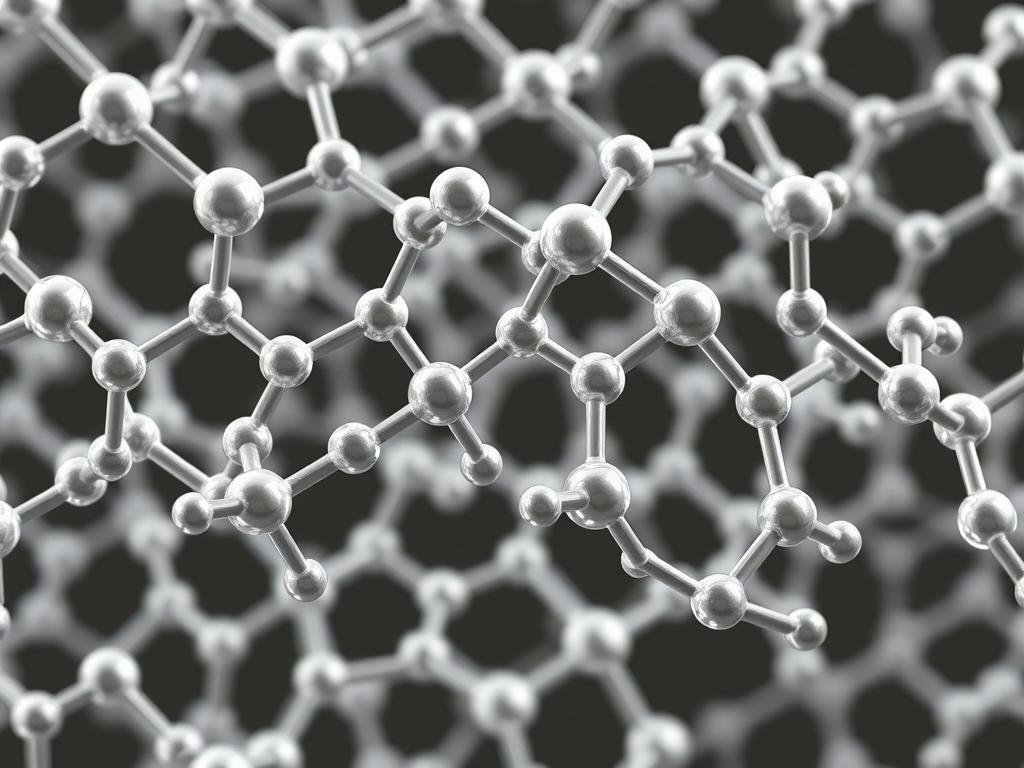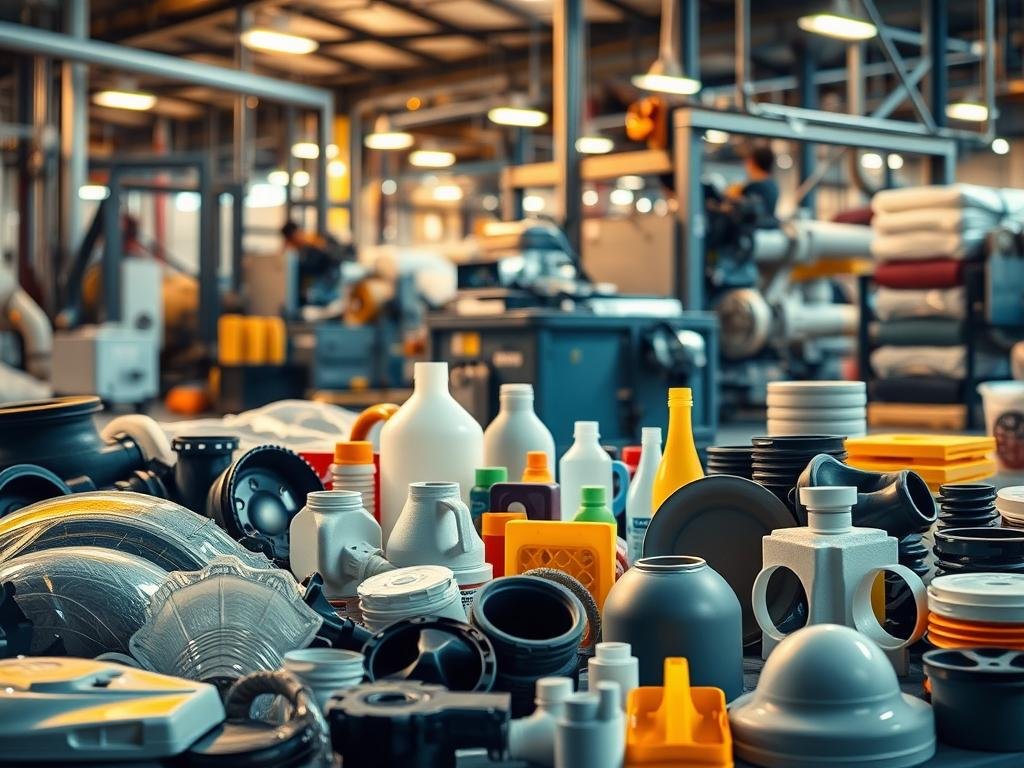Polypropylene (PP) is a versatile thermoplastic 聚合物 用於各行各業。
它的密度範圍從0.855到0.946 g/cm³,使其成為第二多產的商品 塑膠.
The unique properties of PP contribute to its widespread use in various 應用程式.
This guide explores the significance of polypropylene’s material properties, helping engineers and designers make informed decisions.
了解聚丙烯:基本特性與特點
Polypropylene, a widely used thermoplastic, boasts an impressive array of physical properties that make it suitable for a wide range of applications. Its unique combination of characteristics sets it apart from other materials.
聚丙烯是什麼?
聚丙烯(PP)是一種半剛性、半透明且堅韌的塑膠,具有良好的 fatigue resistance 和 耐熱性. 它以較低的知名度而聞名 密度 與其他熱塑性塑料相比,使其在重量敏感的應用中具有優勢。
化學結構與組成
聚丙烯的化學結構特徵在於其 熔點, 其範圍在160-170°C之間,適用於等規型態。這個特性使得聚丙烯能夠用於涉及高溫的應用中 溫度. Its 化學抗性 is also a significant factor in its popularity.
Key Physical Properties Overview
Some of the key physical properties of polypropylene include:
- A 密度 range of 0.895 to 0.93 g/cm³, making it one of the lightest commercial thermoplastics.
- 優秀 抗拒 疲勞,理想用於生活鉸鏈應用。
- 一個平衡 僵硬 和 抗衝擊性 可以通過共聚聚合或添加填料來定制。
These properties make polypropylene a versatile material for various applications, from packaging to automotive components.
聚丙烯的密度:範圍與意義
Understanding the density of polypropylene is essential for material selection. Polypropylene’s density is a critical property that influences its application across various industries.
Standard Density Range of Polypropylene
Polypropylene’s density typically ranges between 0.895 and 0.92 g/cm³, making it one of the lowest density thermoplastics available. This low density is one of its most attractive qualities, allowing the material to be used in situations where saving weight is crucial.
Comparing PP Density to Other Common Polymers
When compared to other common polymers, polypropylene’s density is notably low. For instance, polyethylene has a density range of 0.91-0.96 g/cm³, while PVC ranges from 1.3-1.45 g/cm³. This comparison is crucial for understanding the relative advantages of polypropylene in terms of weight reduction.
| Polymer | Density Range (g/cm³) |
|---|---|
| 聚丙烯 | 0.895-0.92 |
| 聚乙烯 | 0.91-0.96 |
| PVC | 1.3-1.45 |
Why Density Matters in Material Selection
Density directly impacts the weight of finished products, making low-density polypropylene advantageous for transportation applications where fuel efficiency is paramount. In packaging, lower density translates to more units per weight of raw material, potentially reducing material costs and environmental impact.
材料選擇中密度的重要性不容低估。它不僅影響重量,還影響機械性能,例如剛度與重量的比率,這在結構應用中至關重要。對於浮動應用,聚丙烯的密度低於1 g/cm³,確保正浮力。
Molecular Structure and Its Impact on Density
Understanding the molecular configuration of polypropylene is essential for grasping how it influences the material’s density. The molecular structure of polypropylene is complex and can be configured in various ways, affecting its overall properties.

Isotactic, Syndiotactic, and Atactic Configurations
聚丙烯可以存在不同的構型:等規、交替規和無規。等規聚丙烯具有高度的 crystallinity, typically ranging between 30-60% in industrial products. This high crystallinity is due to the regular arrangement of its molecular structure, which contributes to its higher density. Syndiotactic polypropylene is slightly less crystalline, while atactic polypropylene is amorphous, lacking crystallinity.
該領域的一位知名專家曾說過,
“The tacticity of polypropylene significantly influences its physical properties, including density and crystallinity.”
Crystallinity and Its Relationship to Density
結晶性 in polypropylene refers to the percentage of the polymer that exists in an ordered, crystalline state rather than an amorphous, disordered arrangement. Higher crystallinity directly correlates with increased density, as crystalline regions feature more efficiently packed polymer chains compared to amorphous regions.
| 結晶度水平 | 密度影響 | 機械性能 |
|---|---|---|
| High Crystallinity | Higher Density | Increased Stiffness and Tensile Strength |
| Low Crystallinity | Lower Density | Enhanced Flexibility |
The relationship between crystallinity and density is crucial in applications requiring specific optical properties. For instance, higher crystallinity increases opacity, while lower crystallinity enhances transparency. Processing conditions, such as cooling rate, dramatically affect crystallinity and, consequently, the final product’s density and mechanical properties.
製造過程如何影響聚丙烯密度
The manufacturing process plays a crucial role in determining the final density of polypropylene products. Various factors during production can significantly influence the density, making it a critical consideration in material selection.
聚合技術及其影響
聚合技術在建立聚丙烯的初始密度方面具有基本作用。聚合發生的條件,例如 溫度與壓力,會顯著影響所產生聚合物的分子量和密度。例如,若提高聚合反應溫度,所產生的聚丙烯的分子量和密度將會較高,而溫度下降則會產生相反的效果。如業界專家所指出的,“聚合反應條件的控制對於達到所需的材料性能至關重要。”
改變密度的處理參數
後聚合處理技術在決定聚丙烯產品最終密度方面也扮演著重要角色。幾個關鍵的加工參數可以改變密度:
- 加工過程中的冷卻速率至關重要;快速冷卻會降低結晶度和密度,而緩慢冷卻則促進晶體生長並提高密度。
- 在加工過程中加入的成核劑可以促進結晶,產生具有較高密度和改善機械性能的材料。
- 機械取向工藝,例如拉伸或拉伸,會使高分子鏈排列,並增加取向方向的密度。
這些加工條件突顯了在聚丙烯產品中實現所需密度的複雜性。通過仔細控制這些參數,製造商可以生產具有針對特定應用的定制性能的材料。
與聚丙烯密度相關的機械性質
聚丙烯的密度對其機械特性具有深遠的影響,包括拉伸強度、抗衝擊性和疲勞壽命。了解這些特性對於選擇適合特定應用的聚丙烯等級至關重要。
拉伸強度與模數
拉伸強度和模數是受聚丙烯密度影響的重要機械性能。一般而言,較高密度的聚丙烯等級由於其較高的結晶度,展現出較高的拉伸強度和模數。這使它們更適用於需要高剛性和抗變形的應用。
| 密度 (g/cm³) | 抗拉強度 (MPa) | 模數 (GPa) |
|---|---|---|
| 0.89 | 25 | 1.2 |
| 0.91 | 30 | 1.5 |
| 0.93 | 35 | 1.8 |
抗衝擊性與彈性
抗衝擊性和柔韌性也受到聚丙烯密度的顯著影響。較低密度等級由於結晶度較低,通常具有較佳的抗衝擊性,這使得分子具有更大的流動性。這個特性對於可能受到突發衝擊或應力的應用非常重要。
For example, in packaging applications, lower density polypropylene can absorb impacts, reducing the likelihood of damage to the contents.
疲勞抗性與耐久性
聚丙烯卓越的疲勞抗性是其主要優點之一,使其能夠應用於嚴苛的長期用途。密度與疲勞抗性之間的關係較為複雜,經過最佳結晶化的材料能提供最佳的性能平衡。例如,活動鉸鏈依賴聚丙烯能夠彎曲數百萬次而不失效的能力。
“The ability of polypropylene to withstand repeated loading cycles without failure makes it an ideal material for components like living hinges.”
熱性質及其與密度的關係
The relationship between thermal properties and density in polypropylene is a key consideration for designers and engineers. Polypropylene’s performance under various temperature conditions is significantly influenced by its density, which affects its thermal properties.
熔點與熱變形溫度
聚丙烯的熔點和熱變形溫度(HDT)是受其密度影響的關鍵熱性質。熔點是聚丙烯由固態轉變為液態的溫度,而HDT則表示材料在特定負載下開始變形的溫度。一般而言,較高密度的聚丙烯等級具有較高的熔點和HDT值,使其更適用於涉及高溫的應用。
For instance, in applications where polypropylene is exposed to high temperatures, a higher density grade can provide better dimensional stability and resistance to deformation.
Thermal Expansion and Conductivity
聚丙烯展現出相對較高的熱膨脹係數,範圍為每°C 100-150 ×10⁻⁶,與密度呈反比關係。這表示較高密度的聚丙烯等級通常具有較低的膨脹率。聚丙烯的熱傳導率相對較低,介於0.1-0.22 W/m·K之間,並且與密度呈正相關。
這些熱性質的含義在涉及溫度變化的應用中具有重要意義。例如,在受限制的安裝中,因熱膨脹引起的尺寸變化可能導致應力產生。另一方面,聚丙烯的低熱傳導性使其在需要熱隔離的應用中具有價值。
Understanding these thermal properties and their relationship to density is crucial for selecting the appropriate polypropylene grade for specific applications, ensuring optimal performance and durability.
Chemical Resistance Properties Based on Density
The density of polypropylene influences its resistance to various chemicals, making it a crucial consideration for material selection. Polypropylene’s chemical resistance is a key attribute that determines its suitability for applications involving exposure to aggressive substances.
Resistance to Acids, Bases, and Solvents
Polypropylene generally exhibits good resistance to acids, bases, and solvents, but its performance can vary based on its density. Higher density polypropylene tends to have improved chemical resistance due to its increased crystallinity, which reduces the mobility of molecules and limits the penetration of aggressive agents. For instance, polypropylene is resistant to many organic solvents, but it can be affected by chlorinated solvents and some hydrocarbons. The material’s resistance to chemicals is also influenced by temperature and the presence of stress.
Environmental Stress Cracking Resistance
Environmental stress cracking resistance (ESCR) is a critical property for polypropylene, particularly in applications where it is exposed to mechanical stress and aggressive chemicals simultaneously. Higher density polypropylene grades typically demonstrate superior ESCR due to their increased crystallinity. This property is vital in applications such as chemical storage tanks and pressurized piping, where the material is under load and exposed to potentially aggressive chemicals. Balancing ESCR with impact resistance is essential, as higher crystallinity can reduce impact performance. Specialized high-crystallinity polypropylene grades with densities toward the upper end of the typical range (0.92-0.94 g/cm³) offer the best ESCR performance, especially when combined with appropriate stabilizer packages.
Polypropylene Grades and Their Density Variations
Understanding the range of polypropylene grades and their associated density variations is crucial for material selection. Different applications require polypropylene materials with specific density characteristics, achieved through various grades.
Homopolymers vs. Copolymers
聚丙烯均聚物和共聚物代表了這種多功能材料的兩個主要類別。均聚物由完全由丙烯單體組成,通常具有較高的結晶度和密度,相較於共聚物。共聚物則加入了如乙烯等額外單體,提供更佳的抗衝擊性和較低的密度。在選擇均聚物或共聚物時,取決於具體的應用需求,均聚物常用於需要高剛性和耐化學性的場合,而共聚物則較適用於需要更大柔韌性和韌性的應用。
Filled and Reinforced Grades
填充和增強聚丙烯等級旨在通過加入添加劑或增強材料來提升特定性能。填充劑如碳酸鈣或滑石粉可以增加剛性並降低成本,而增強材料如玻璃纖維則能顯著改善機械性能。這些修改也可能影響材料的密度。例如,玻璃纖維增強通常會增加密度,同時提升拉伸強度和抗載變形能力。
Specialty Grades for Specific Applications
專用聚丙烯等級是為特定應用量身定制的,通常具有精心控制的密度分佈。例如,醫療級聚丙烯設計具有精確的分子量分佈和密度輪廓,並結合卓越的純度和生物相容性。高透明度等級通過受控結晶和專用成核劑實現增強的透明度。擴展聚丙烯(EPP)是一種特殊形式,通過受控發泡工藝大幅降低密度,具有卓越的能量吸收性能。
密度是關鍵因素的應用
The unique density of polypropylene makes it an ideal material for various applications across different sectors. Its density of approximately 0.9 g/cm³ is less than that of water, making it naturally buoyant and suitable for applications where buoyancy is crucial.
輕量化汽車零件
在汽車產業中,聚丙烯的低密度有助於生產輕量化的零件,提升燃油效率並降低排放。其抗衝擊性和柔韌性也使其適用於各種內外飾件。
包裝與容器解決方案
Polypropylene’s density and chemical resistance make it a popular choice for packaging and container solutions. It is used in producing containers, bottles, and other packaging materials that require durability and resistance to various substances.
| 應用程式 | Benefits of Polypropylene |
|---|---|
| 汽車零件 | Lightweight, impact-resistant |
| 包裝解決方案 | Chemically resistant, durable |
| 浮力應用 | 浮力,抗水浸 |
浮力應用
聚丙烯在水中的浮力使其非常適合用於海洋和水域應用。它被用於製造浮動碼頭、浮筒、海上浮標,以及休閒設備如皮划艇和划水板。該材料對環境壓力和紫外線曝露的抗性,進一步增強了其在這些應用中的適用性。

The combination of low density, chemical resistance, and durability makes polypropylene a versatile material for a wide range of applications. Its suitability for lightweight automotive components, packaging solutions, and buoyancy applications underscores its value in various industries.
Material Selection Guide: Choosing the Right Polypropylene Density
密度 of polypropylene 是材料選擇中的一個關鍵因素,影響性能和生產成本。在選擇聚丙烯等級時,了解應用的需求至關重要。
確定應用需求
選擇正確的 聚丙烯密度, one must first identify the application’s needs, including mechanical properties, thermal resistance, and chemical resistance. The application’s requirements will dictate the optimal density for the material.
在其他屬性中平衡密度
Material 選擇涉及在密度與其他性質如抗拉強度、抗衝擊性等之間取得平衡 processing 特徵。較低密度 polypropylene 等級在某些方面可以提供優勢 成本 以及重量減輕。
與密度相關的成本考量
成本 是一個重要因素在 生產低密度聚丙烯每公斤可產生更多零件,可能降低整體 成本. 然而,總成本評估必須考慮整個產品生命週期,包括運輸和終止使用情境。
總結來說,選擇合適的聚丙烯密度需要全面評估應用需求、材料特性,以及 成本 考量因素。透過了解這些因素,製造商可以優化其材料選擇,以提升性能並降低成本。
結論:根據聚丙烯密度做出明智的決策
As we’ve explored, 聚丙烯密度 是材料性能的關鍵因素。了解其細微差異為材料選擇提供了基本框架,使工程師和設計師能夠根據應用特定需求做出明智的決策。
The relationship between 密度 and other critical 屬性—including mechanical strength, thermal resistance, and chemical durability—creates a complex decision matrix. Modern polypropylene materials offer versatility through carefully controlled density profiles, from lightweight copolymers for impact-critical 應用程式 to higher density homopolymers for structural components.
By leveraging a comprehensive understanding of how 密度 influences polypropylene’s behavior, manufacturers can optimize material selection for specific 應用程式, 在經濟與環境考量下平衡性能需求。催化劑技術與加工技術的持續演進,預示著更高的控制能力。 polypropylene’s 密度及相關性質,擴展材料的應用潛力。
